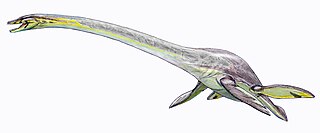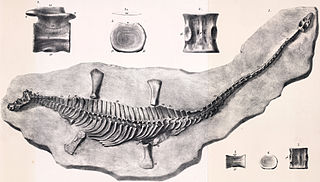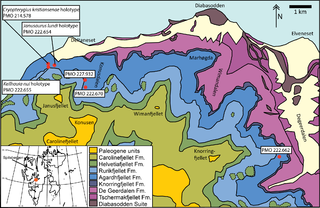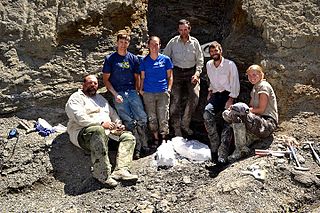
Plesiosauroidea is an extinct clade of carnivorous marine reptiles. They have the snake-like longest neck to body ratio of any reptile. Plesiosauroids are known from the Jurassic and Cretaceous periods. After their discovery, some plesiosauroids were said to have resembled "a snake threaded through the shell of a turtle", although they had no shell.

Pliosauroidea is an extinct clade of plesiosaurs, known from the earliest Jurassic to early Late Cretaceous. They are best known for the subclade Thalassophonea, which contained crocodile-like short-necked forms with large heads and massive toothed jaws, commonly known as pliosaurs. More primitive non-thalassophonean pliosauroids resembled plesiosaurs in possessing relatively long necks and smaller heads. They originally included only members of the family Pliosauridae, of the order Plesiosauria, but several other genera and families are now also included, the number and details of which vary according to the classification used.

Umoonasaurus is an extinct genus of plesiosaur belonging to the family Leptocleididae. This genus lived approximately 115 million years ago during the Early Cretaceous period, in shallow seas covering parts of what is now Australia. It was a relatively small animal around 2.5 metres (8.2 ft) long. An identifying trait of Umoonasaurus is three crest-ridges on its skull.

Plesiopleurodon is an extinct genus of Mesozoic marine reptiles, belonging to Sauropterygia, known from the Late Cretaceous of North America. It was named by Kenneth Carpenter based on a complete skull with a mandible, cervical vertebra, and a coracoid. In naming the specimen, Carpenter noted "Of all known pliosaurs, Plesiopleurodon wellesi most closely resembles Liopleurodon ferox from the Oxfordian of Europe, hence the generic reference." It was initially described as a pliosaur due to it short neck, a common trait of the family, although it is in the order Plesiosauria. However, later exploration into the relationships of both orders indicate that not all pliosaurs have short necks and not all plesiosaurs have long necks.

Colymbosaurus is a genus of cryptoclidid plesiosaur from the Late Jurassic (Callovian-Tithonian) of the UK and Svalbard, Norway. There are two currently recognized species, C. megadeirus and C. svalbardensis.

Nannopterygius is an extinct genus of ophthalmosaurid ichthyosaur that lived during the Middle Jurassic to the Early Cretaceous. Fossils are known from England, Kazakhstan, Russia, and Norway and six species are currently assigned to the genus.

Tricleidus is an extinct genus of cryptoclidid plesiosaur known from only specimen from the middle Jurassic of United Kingdom. It was first named by Andrews in 1909 and the type species is Tricleidus seeleyi.

Jørn Harald Hurum is a Norwegian paleontologist and popularizer of science. He is a vertebrate paleontologist and holds an associate professor position at the Natural History Museum of the University of Oslo. He has studied dinosaurs, primitive mammals and plesiosaurs.

Rhomaleosauridae is a family of plesiosaurs from the Earliest Jurassic to the latest Middle Jurassic of Europe, North America, South America and possibly Asia. Most rhomaleosaurids are known from England, many specifically from lower Blue Lias deposits that date back to the earliest Jurassic, just at the boundary with the Triassic. In fact, to date only two undisputed rhomaleosaurids were named from outside Europe - the closely related Borealonectes russelli and Maresaurus coccai from Canada and Argentina, respectively. These two species are also the only Middle Jurassic representatives of the family. Rhomaleosauridae was formally named by Kuhn in 1961, originally proposed to include Rhomaleosaurus cramptoni and its relatives, which have short necks and large heads relatively to plesiosauroids like Elasmosaurus and Plesiosaurus, but longer necks and smaller heads relatively to advanced pliosaurids like Pliosaurus and Kronosaurus.
Abyssosaurus is an extinct genus of cryptoclidid plesiosaur known from the Early Cretaceous of Chuvash Republic, western Russia. It possessed a shortened skull, and it has been suggested that it primarily inhabited the bathyal zone.

Eoplesiosaurus is an extinct genus of basal plesiosauroid known from the Early Jurassic period of the United Kingdom. It contains a single species, E. antiquior.

Microcleididae is an extinct family of basal plesiosauroid plesiosaurs from the Early Jurassic of France, Germany, Portugal and the United Kingdom. Currently, the oldest and the most known microcleidid is Eretmosaurus from the middle Sinemurian of the United Kingdom. Microcleididae was formally named and described by Roger B. J. Benson, Mark Evans and Patrick S. Druckenmiller in 2012.
Spitrasaurus is an extinct genus of cryptoclidid plesiosauroid plesiosaur known from the uppermost Jurassic of central Spitsbergen, Norway and likely also Kimmeridge, England. It is named after a syllabic abbreviation for Spitsbergen Travel.

Cryopterygius is an extinct genus of ophthalmosaurid ichthyosaur known from the uppermost Jurassic of Central Spitsbergen, Norway. The type species, Cryopterygius kristiansenae , is known from a single, but largely complete specimen from the Slottsmøya Member of the Agardhfjellet Formation. With a total length of 5–5.5 metres (16–18 ft), it is a large ichthyosaur. A second species, C. kielanae, was found in the Kcynia Formation from the Late Jurassic of Poland. It is smaller than the type species, with a length of 3.5–4 metres (11–13 ft).
Palvennia is an extinct genus of ophthalmosaurid ichthyosaurian known from the uppermost Jurassic of Central Spitsbergen, Norway. It was named for PalVenn, the Friends of the Palaeontological Museum in Oslo, whose expedition led to the discovery of the type specimen. Palvennia was a medium-sized ichthyosaur, measuring 3–4 m (9.8–13.1 ft) long. It is known from a single skull from the Slottsmøya Member of the Agardhfjellet Formation that measures 86 cm long. It is unusual in having a very short rostrum, similar to Ichthyosaurus breviceps. Because of this, the orbit seems very large, but this may be effected by crushing. The single and only known species is Palvennia hoybergeti Druckenmiller et al., 2012. In 2019, Palvennia was synonymized with Arthropterygius, though maintained as a separate species, by Nikolay Zverkov and Natalya Prilepskaya, although this synonymy was objected to later that same year by Lene Delsett and colleagues, who maintained that they were sufficiently different to warrant separate genera.

This timeline of plesiosaur research is a chronologically ordered list of important fossil discoveries, controversies of interpretation, taxonomic revisions, and cultural portrayals of plesiosaurs, an order of marine reptiles that flourished during the Mesozoic Era. The first scientifically documented plesiosaur fossils were discovered during the early 19th century by Mary Anning. Plesiosaurs were actually discovered and described before dinosaurs. They were also among the first animals to be featured in artistic reconstructions of the ancient world, and therefore among the earliest prehistoric creatures to attract the attention of the lay public. Plesiosaurs were originally thought to be a kind of primitive transitional form between marine life and terrestrial reptiles. However, now plesiosaurs are recognized as highly derived marine reptiles descended from terrestrial ancestors.

The Agardhfjellet Formation is a geologic formation in Svalbard, Norway. It preserves fossils dating back to the Oxfordian to Berriasian stages, spanning the Late Jurassic-Early Cretaceous boundary. The formation contains the Slottsmøya Member, a highly fossiliferous unit (Lagerstätte) where many ichthyosaur and plesiosaur fossils have been found, as well as abundant and well preserved fossils of invertebrates.

Patrick S. Druckenmiller is a Mesozoic paleontologist, taxonomist, associate professor of geology, Earth Sciences curator, and museum director of the University of Alaska Museum of the North, where he oversees the largest single collection of Alaskan invertebrate and vertebrate fossils. He has published work on plesiosaurs, ichthyosaurs, mastodons, and dinosaurs in the United States, Svalbard, and Canada. He has co-authored papers on discussions of mass extinctions and biogeography. Much of his work has focused on Arctic species. He is a member of the Spitsbergen Jurassic Research group, which focuses on marine reptiles. Druckenmiller has named many new genera and species, including Edgarosaurus muddi, Nichollsia borealis, Athabascasaurus bitumineus, Cryopterygius kristiansenae, Spitrasaurus larseni, and Spitrasauruswensaasi.




















